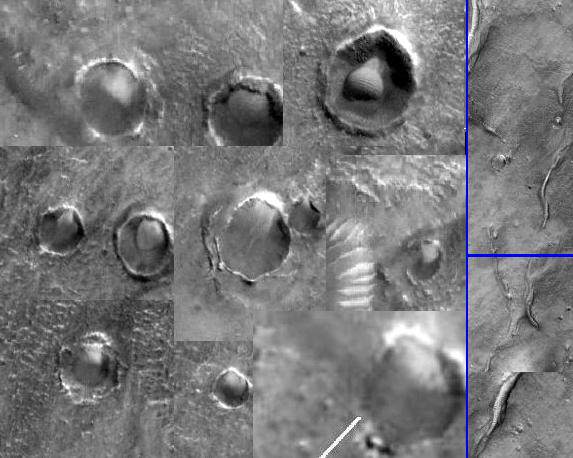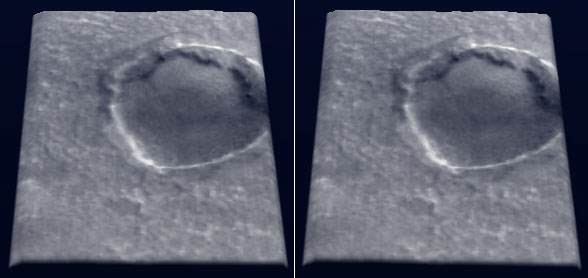(continued)
Image Enhancements by Eric C. Lausch © 2001 Danger Zone! Productions In layman's terms, "These craters appear to be convex rather than concave like your normal well behaved crater should be." A group of researcher's headed by Nadine Barlow of the Department of Physics at the University of Central Florida in Orlando is researching the morphology of unusual craters on the surface of Mars. Space.com recently ran an article describing the groups efforts. "Barlow led a study team looking into sub-surface ice and water reservoirs. Her colleagues on the work are John Koroshetz of Laser Energetics in Oviedo, Florida, and James Dohm of the Department of Hydrology and Water Resources at the University of Arizona in Tucson. The group reported they have taken hard looks at the smooth plains of Solis Planum, an area peppered with impact craters and material excavated from those craters. Their work focuses on looking at the morphology of craters -- shapes and forms -- and the deposits, or ejecta, spewed out from craters during their creation. Crater size and the ejecta patterns are considered signposts for what lies beneath -- in this case possible subsurface water, in both icy and liquid form.
The team reported that they culled through Mars surface images taken in the 1970s by two Viking Orbiters. Using those photos, the locations and
diameters of hundreds of craters were mapped and cataloged. To shore up their case for a reservoir, laser data taken by the Mars Global Surveyor spacecraft of nearly 1,000 craters of varying diameters and depths
was reviewed. Doing so, the team double-checked the methodology they used to grasp depth-diameter relationships for Martian craters. Results of the research show smaller than average onset diameters of single
layer craters in Solis and Thaumasia Planae, strongly suggesting a near-surface ice reservoir in this area.
The geologic and tectonic history of the Tharsis region -- the area in which
the suspected reservoir sits -- provides a possible explanation for the
localized concentration of ice and water, the team reported. Long-term
activity in this region would have tilted the water table, pooling the
material in the topographic low of Solis Planum. "Heat associated with Tharsis may have maintained deep volatiles as liquid for a longer time period than elsewhere in the Martian equatorial region," the team reported. This unusual near-surface ice-reservoir may be easily accessible given its depth of around 360 feet (110 meters). "The next stage of this study will be to look at reasonable values of porosity and water concentrations to gain a better understanding of how much ice and water may actually be contained within this reservoir," Barlow said.
Underground water influencing crater morphology-Johnny Danger's going to
have a field day with this one!
One possible explanation for the inappropriate lighting on the wrong sides
of these craters may be rime ice. The Encyclopedia Britannia defines rime ice as:
Rime is composed of small ice particles with air pockets between them; this
structure causes its typical white appearance and granular structure.
Because of the rapid freezing of each individual super cooled droplet, there
is relatively poor cohesion between the neighboring ice particles, and the
deposits may easily be shattered or removed from objects they form on.
Thus, rime is not normally a serious problem when it forms on the wings or
other surfaces of aircraft.
While rime ice is an explanation that would most likely please the folks at
JPL, stereo and 3D image analysis leads this author to a different
conclusion.

Image crops from M1501228d and M1501228a Above are crops from M1501228d and M1501228a respectively. Of all the anomalous craters in Johnny Danger's crater image these two seem to belong to a particular "class" of phenomena. What that phenomena is one can only speculate. But they appear to be related and they are highly unusual. As we previously noted, the illumination or sun angle is from the upper right and what see in this image supports that contention as well as raising a number of interesting questions. Both craters appear to have large spherical objects contained within their respective boundaries. On the left side (M1501228d)this sphere appears as if it is rising from beneath the surface of Mars like some gigantic egg or puffball. One can clearly see the crennelated edge of the crater's overhanging lip and the associated shadows cast by it. On the right side (M1501228a)we would seem to see a similar object, raised somewhat further above the crater floor. Note the illuminated upper right side and shadowed lower left side. This is indicative of a raised spherical structure. Craters with domes in them. Enormous domes! A width of 38 pixels at 4.47m per pixel yields a diameter of 169.86 meters or 557.28 feet! The magnitude of scale becomes apparent for those of you who have visited the dome at Walt Disney World's Epcot Center which spans a mere 265 feet in diameter!
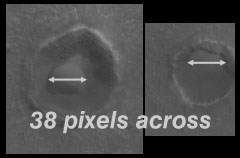
Comparison of anomalous crater domes from M1501228d and M1501228a
While not statistically significant due to the small sampling size of two, I
find it strangely compelling that these "domes" are exactly the same size
and have the same apparent surface textures.
Not approximately the same size- exactly the same size (as can reasonably be determined by photographic analysis)!
This something that does not normally occur in a geological sense.
No two boulders are exactly the same size or mass and have such perfect
concentricity.
 Spherical boulders on the New Zealand Coast Likewise in nature-no two water droplets freeze to produce identical hailstones-like snowflakes, they all have unique characteristics. No two puffballs grow to the exact same dimensions. The list goes on and on. Only items designed, engineered and fabricated by technological means can be reproduced with such exacting similarity. In this author's opinion the geographically adjacent locations of the "Glass Tunnel" anomalies and "Crater Dome" anomalies is more than mere coincidence. I feel they are related in some manner. I find it ironic that the planetary science community is apparently not interested in further investigation of items of such monumental proportion and unusual characteristics. Although this is not the proper forum for speculation of this nature- we would be remiss not to mention the possibility that this could be the product of some technology rather than a naturally occurring entity. If the "Glass Tunnels" are indeed for water recirculation as some (including myself) have speculated perhaps this is some type of filtration\purification facility. Or perhaps a domed arcology. One that would fill Buckminster Fuller with envy. The most efficient geometric shape is a sphere as it uses the smallest surface area to enclose a given space. (I find it interesting to note that the basic structural unit of most Earthly geodesic domes is the tetrahedron.) As geodesic domes require no internal columns for support, these self-supporting structures make an excellent choice for venues requiring unobstructed interior space. Another interesting correlation to the arcology model is that domes can actually "weigh less" than the materials used to construct them due to the air mass inside the dome! When the inside air mass temperature is greater than the outside ambient air temperature a net lifting effect analogous to a hot air balloon is created. While not noticeable in house sized domes, as the spheres diameter increases this effect is increased geometrically becoming quite noticeable in large venues such as a professional sports facility. Theoretically a sphere of little more than of a half mile in diameter would be able to float in the air with only a 1 degree Fahrenheit difference in temperature in Earth normal gravity! At a little over one tenth of a mile in diameter in Mars 40% Earth gravity our "crater dome" anomalies would experience a pronounced lifting effect. It would seem a reasonable hypothesis to conclude that this effect may be the cause for the difference in elevation between our two "crater dome" anomalies, if one can verify that they are indeed hollow and that there is sufficient temperature differential to create this lifting effect. As for the reasons behind this possible temperature variation one can only speculate. But such speculation is best left to the likes of Johnny Danger and his cohorts. The rest of us will just have to wait until the ESA Mars probe targets it's ground penetrating radar and infra red camera at these unusual features on the surface of Mars.
3D rendering of crop from M1501228a by Chris Joseph
As this first "crater dome" anomaly has been discussed thoroughly in other
venues we will not expend great effort to discuss it's unusual nature.
As a stand alone item it is highly unusual but not much can be gleaned from
it's discovery other than to say, "my, that's odd..."
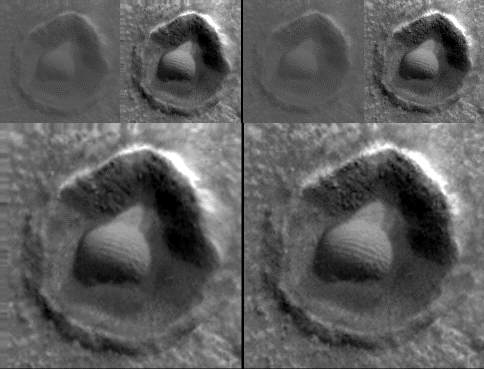
3D Stereo pair analysis of crop from M1501228a by Chris Joseph
However, with the revelation of a second apparently identical "crater dome"
anomaly one can begin to classify these anomalies as belonging to a
particular class or order of objects. The geographically adjacent location
of these domes in regards to the "glass tunnels" of Mars tends to lend
credence to the theory that what we are observing is part of an complex
interdependent system. A underground network of interconnected tunnels connecting to various points on the surface of Mars.
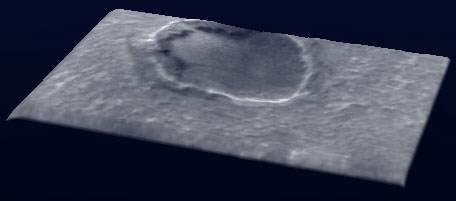
3D rendering by of crop from M1501228d by Chris Joseph
3D Stereo pair of crop from M1501228d by Chris Joseph
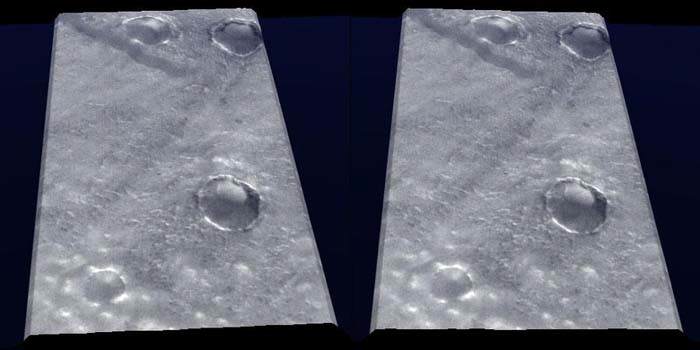
3D Stereo Pairing of crop from M1501228d by Chris Joseph
Here one can clearly see one of the "tunnels" terminating into our second
"crater dome" anomaly while another branch heads off at a 90 degree angle to the first tunnel.

3D Stereo Pairing of crop from M1501228d by Chris Joseph
A look at the "Big Picture" At the very least this area of Mars deserves further scrutiny by NASA and the ESA on future Mars missions if for no other reason than to further our knowledge of planetary science. With additional imaging, both conventional and infra-red, ground penetrating radar analysis and spectrometer data we can move this discussion into the realm of hard science. Without additional data of this nature, one can only judge what one sees based on a single highly anomalous image and decide for one's own self what this image represents. This is why we must remain proactive and support efforts to lobby our elected officials and taxpayer funded scientific organizations by groups such as FACETS. To not actively support and participate in such endeavors is in effect abandoning the quest for a better understanding of the nature of our universe. And, if after attempting to garner a better understanding of such mysteries via inquiries directed to our taxpayer funded governmental organizations you reach the same conclusions that I and many others have arrived at, namely that there is a fundamental problem with the quality of science being conducted in regards to possible alien artifacts in our solar system, you may also wish to investigate other similar anomalies on your own, as we have attempted to do with the article you've just read. We heartily encourage you to do so.
|
